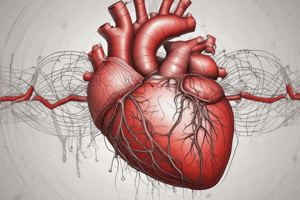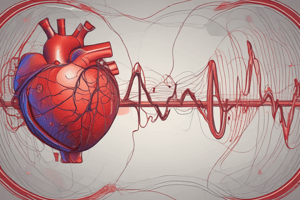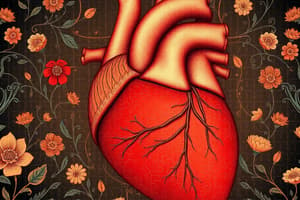Podcast
Questions and Answers
What is the main characteristic of diastole in the heart contraction cycle?
What is the main characteristic of diastole in the heart contraction cycle?
- Heart expands and fills with blood (correct)
- Heart contracts and pumps blood out
- Blood flows from arteries to veins
- Valves close to prevent blood flow
Which chambers of the heart distend during diastole?
Which chambers of the heart distend during diastole?
- Arteries
- Capillaries
- Ventricles
- Atria (correct)
What is the role of the AV node in early diastole?
What is the role of the AV node in early diastole?
- Coordinates electrical signals between atria and ventricles (correct)
- Prevents blood backflow in veins
- Pumps blood from ventricles to atria
- Controls blood flow in arteries
Why does the AV node send electrical impulses to the ventricles at a slower pace in early diastole?
Why does the AV node send electrical impulses to the ventricles at a slower pace in early diastole?
What happens to the ventricles in late diastole?
What happens to the ventricles in late diastole?
Which structure ensures proper synchronization between atrial and ventricular contractions?
Which structure ensures proper synchronization between atrial and ventricular contractions?
What is the main function of papillary muscles within the ventricles?
What is the main function of papillary muscles within the ventricles?
During which phase of the heart contraction cycle do the semilunar valves close?
During which phase of the heart contraction cycle do the semilunar valves close?
What facilitates the process of ventricular contraction in the heart muscle?
What facilitates the process of ventricular contraction in the heart muscle?
Why do the pulmonary and aortic valves open during the heart contraction cycle?
Why do the pulmonary and aortic valves open during the heart contraction cycle?
What happens once the ventricular ejection is complete during systole?
What happens once the ventricular ejection is complete during systole?
Which phase of systole involves a transient drop in pressure inside the ventricles?
Which phase of systole involves a transient drop in pressure inside the ventricles?
Study Notes
The Heart Contraction Cycle: From Diastole to Systole
Overview
Understanding the heart contraction cycle is essential for comprehending the cardiovascular system's functioning. It involves the coordinated activity of various structures within the heart, including the atria and ventricles, as well as the valves that control blood flow between these chambers. In this article, we delve into the details of the heart contraction cycle, focusing on the stages of diastole and systole and their roles in maintaining efficient cardiac output.
Diastole
Diastole is the phase of the heart contraction cycle where the heart expands and fills with blood. During this phase, the atria (upper chambers) and ventricles (lower chambers) both distend due to the pressure difference between the chambers. There are two main types of diastole: early diastole and late diastole.
Early Diastole
Atrioventricular (AV) node plays a crucial role in coordinating the timing of electrical signals between the atria and ventricles. As the AV node receives electrical impulses from the sinoatrial (SA) node, it sends them out at a slower pace to the ventricles via the bundle of His and Purkinje fibers. This delay ensures proper synchronization between the atrial and ventricular contractions.
Late Diastole
As the ventricles start filling with blood, they remain relatively relaxed. However, the presence of papillary muscles within the ventricles helps prevent the backward flow of blood from the ventricles to the atria. These muscles contract slightly, further reducing the risk of regurgitation.
Systole
Systole is the phase of the heart contraction cycle where the heart contracts and forces blood through the circulatory system. It is divided into three stages: ventricular contraction, ventricular ejection, and diastolic runoff.
Ventricular Contraction
After reaching maximal size during diastole, the ventricles begin to contract due to the force of the actin-myosin interaction. This process is facilitated by calcium ions entering the myocytes, causing the sarcomeres in the heart muscle to shorten. As the ventricles contract, the pressure within them rises rapidly, pushing blood against closed semilunar valves towards the pulmonary artery and aorta.
Ventricular Ejection
When the atrial pressures increase due to the closing of the tricuspid and mitral valves, the pulmonary and aortic valves open to allow blood to flow out of the ventricles. The opening of these valves creates a very brief period of time when the pressure inside the ventricles is momentarily lower than the pressure outside of them. This transient drop in pressure allows blood to leave the ventricles efficiently without any significant backflow into the heart.
Diastolic Runoff
Once the ventricular ejection is complete, the pressure inside the ventricles decreases, allowing the atrial pressures to take over again. The result is another rapid rise in atrial pressures, which in turn opens the tricuspid and mitral valves. The semilunar valves close after ejection, preventing the blood from flowing back into the ventricles.
Throughout the entire heart contraction cycle, the valves play a vital role in ensuring that blood flows in only one direction. They maintain this unidirectional flow by adjusting their positions based on the pressure differences across them.
Studying That Suits You
Use AI to generate personalized quizzes and flashcards to suit your learning preferences.
Description
Test your knowledge on the heart contraction cycle, including the phases of diastole and systole, the role of atrioventricular node, papillary muscles, and the stages of ventricular contraction, ejection, and diastolic runoff. Explore how the heart efficiently pumps blood through the circulatory system.




